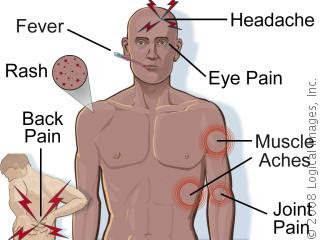Dengue fever, also known as breakbone fever, is an infectious tropical disease caused by the dengue virus. Symptoms include fever, headache, muscle and joint pains, and a characteristic skin rash that is similar to measles. In a small proportion of cases the disease develops into the life-threatening dengue hemorrhagic fever, resulting in bleeding, low levels of blood platelets and blood plasma leakage, or into dengue shock syndrome, where dangerously low blood pressure occurs.
Dengue is transmitted by several species of mosquito within the genus Aedes, principally A. aegypti. The virus has four different types; infection with one type usually gives lifelong immunity to that type, but only short-term immunity to the others. Subsequent infection with a different type increases the risk of severe complications. As there is no vaccine, prevention is sought by reducing the habitat and the number of mosquitoes and limiting exposure to bites.
Treatment of acute dengue is supportive, using either oral or intravenous rehydration for mild or moderate disease, and intravenous fluids and blood transfusion for more severe cases. The incidence of dengue fever has increased dramatically since the 1960s, with around 50–100 million people infected yearly. Early descriptions of the condition date from 1779, and its viral cause and the transmission were elucidated in the early 20th century. Dengue has become a global problem since the Second World War and is endemic in more than 110 countries. Apart from eliminating the mosquitoes, work is ongoing on a vaccine, as well as medication targeted directly at the virus. wikipedia
Hyperthermia
Hyperthermia is an elevated body temperature due to failed thermoregulation. Hyperthermia occurs when the body produces or absorbs more heat than it can dissipate. When the elevated body temperatures are sufficiently high, hyperthermia is a medical emergency and requires immediate treatment to prevent disability or death.
The most common causes are heat stroke and adverse reactions to drugs. Heat stroke is an acute condition of hyperthermia that is caused by prolonged exposure to excessive heat or heat and humidity. The heat-regulating mechanisms of the body eventually become overwhelmed and unable to effectively deal with the heat, causing the body temperature to climb uncontrollably. Hyperthermia is a relatively rare side effect of many drugs, particularly those that affect the central nervous system. Malignant hyperthermia is a rare complication of some types of general anesthesia.
Hyperthermia can be created artificially by drugs or medical devices. Hyperthermia therapy may be used to treat some kinds of cancer and other conditions, most commonly in conjunction with radiotherapy.
Hyperthermia differs from fever in the mechanism that causes the elevated body temperatures: a fever is caused by a change in the body's temperature set-point.
The opposite of hyperthermia is hypothermia, which occurs when an organism's temperature drops below that required for normal metabolism. Hypothermia is caused by prolonged exposure to low temperatures and is also a medical emergency requiring immediate treatment. wikipedia
Nursing Interventions for Dengue Fever - Hyperthermia
Hyperthermia Settings
- Monitor the temperature as needed
- Monitor blood pressure, pulse and respiration
- Monitor the temperature and skin color
- Monitor and report signs and symptoms of hyperthermia
- Encourage intake of fluids and adequate nutrition
- Teach clients how to prevent high heat
- Give antipyretic drugs
- Give drugs to prevent or control the shivering
Hyperthermia Treatment
- Monitor the temperature as needed
- monitor IWL
- Monitor the temperature and skin color
- Monitor blood pressure, pulse and respiration
- Monitor the degree of impairment of consciousness
- Monitor the ability of the activity
- Monitor leukocytes, hematocrit, hemoglobin
- Monitor intake and output
- Monitor cardiac arrhythmias
- Encourage increased fluid intake
- Give intravenous fluids
- Increase air circulation with a fan
- Push or do oral hygiene
- Give antipyretic drugs to prevent the client shivering / seizures
- Give antibiotic drugs to treat the cause of fever
- Give oxygen
- Cold compress on the groin, forehead and axilla.
- Encourage clients not to wear a blanket
- Encourage clients to wear clothes made from cold, thin and absorbs perspiration
Environmental Management
- Give the room as indicated
- Give your bed and cloth / linen, clean and comfortable
- Limit visitors
Infection Control
- Encourage clients to wash their hands before eating
- Use soap to wash hands
- Wash hands before and after doing client care activities
- Replace the infusion and clean place in accordance with SOP
- Give your skin care in the area of edema
- Encourage clients to get enough rest
- Perform infusion with aseptic technique
- Encourage clients to take antibiotics according to doctors advice.

